There’s something truly special about the rich, savory flavors of Korean beef dishes. From the iconic Bulgogi to the succulent Galbi, these meals are a celebration of taste and tradition. My love for these dishes started with their bold marinades and tender meat, and I’m excited to share my favorite recipes with you.
Whether you’re a fan of authentic flavors or enjoy creative fusion twists, this article has something for everyone. I’ve included tips from culinary experts like Chef John to ensure your dishes turn out perfectly. From quick weeknight meals to elaborate weekend feasts, these recipes are designed to bring joy to your kitchen.
Key Takeaways
- Explore the rich flavors of traditional Korean beef dishes like Bulgogi and Galbi.
- Learn expert marinade techniques to enhance your cooking.
- Discover fusion recipes that combine Korean flavors with modern twists.
- Find quick and easy meals perfect for busy weeknights.
- Get inspired to create restaurant-quality dishes at home.
Introduction to Korean Beef Recipes
The first time I tasted marinated short ribs, I knew I was hooked on the flavors of Korean BBQ. The savory-sweet balance, combined with the smoky aroma, created an unforgettable experience. Since then, these dishes have become a staple in my kitchen, and I’m excited to share why they hold such a special place in my heart.
Why I Love Korean Beef
What makes these recipes so unique is the art of marination. Ingredients like soy sauce, garlic, and sesame come together to create a flavor profile that’s both rich and complex. The first time I tried bulgogi, I was amazed at how tender and flavorful the beef was. It’s not just about the taste—it’s about the joy of preparing and sharing these meals with loved ones.
A Brief Look at Korean BBQ Culture
Korean BBQ is more than just a meal—it’s a cultural experience. The communal aspect of grilling meat at the table, paired with an array of banchan (side dishes), makes it a social event. Dishes like marinated short ribs and bulgogi are central to this tradition, showcasing the importance of balance in flavors and textures. The use of ingredients like ginger, red pepper, and pepper flakes adds depth and warmth to every bite.
In the next sections, we’ll dive deeper into these recipes and explore creative ways to bring the flavors of Korean BBQ into your home. Whether you’re a seasoned cook or just starting, there’s something here for everyone.
Essential Korean BBQ Favorites
The art of Korean BBQ lies in its simplicity and depth of flavor. Whether you’re grilling at home or hosting a gathering, these dishes are sure to impress. Let’s explore two classics: Bulgogi and Galbi.
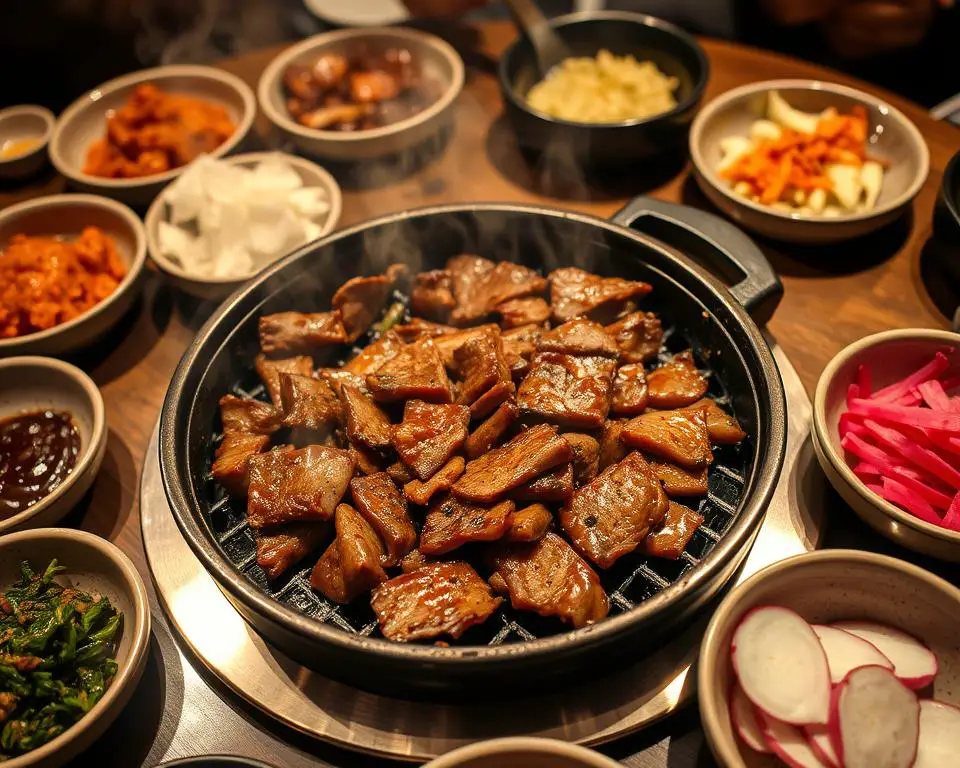
Korean Bulgogi: Marinade Magic
Bulgogi is a staple in Korean cuisine, known for its tender, thinly sliced beef. The secret lies in the marinade. Combine soy sauce, sesame oil, garlic, and a touch of sugar for sweetness. Adding grated Asian pear or cola helps tenderize the meat, giving it that melt-in-your-mouth texture.
For one pound of beef, mix:
- 1/4 cup soy sauce
- 1 tbsp sesame oil
- 2 cloves minced garlic
- 1 tbsp sugar
- 1/4 grated Asian pear
Marinate for at least 30 minutes, then grill or pan-fry for a quick, flavorful meal.
Galbi: Tender Short Ribs
Galbi, or marinated short ribs, are another favorite. Using flanken-style ribs ensures even cooking and maximum tenderness. The marinade often includes soy sauce, garlic, and red pepper flakes for a hint of spice. Grilling these ribs creates a caramelized crust that’s simply irresistible.
For the best results, marinate the ribs overnight. This allows the flavors to penetrate deeply, resulting in juicy, flavorful meat.
Tips for Perfect Korean BBQ at Home
Grilling Korean-style beef at home is easier than you think. Here are some tips to get it right:
- Use a mix of sesame oil and soy sauce for a balanced marinade.
- Add red pepper flakes or ginger for a spicy kick.
- Grill over medium heat to avoid burning the marinade.
- Serve with traditional banchan like kimchi and pickled radishes for an authentic experience.
| Dish | Key Ingredients | Cooking Method |
|---|---|---|
| Bulgogi | Soy sauce, sesame oil, garlic, sugar | Grill or pan-fry |
| Galbi | Soy sauce, garlic, red pepper flakes | Grill |
Fusion and Creative Korean Beef Dishes
Exploring fusion dishes with Korean beef has been one of my favorite culinary adventures. By blending traditional flavors with global influences, I’ve created recipes that are both innovative and comforting. Let’s dive into two of my go-to fusion dishes: Korean Beef Tacos and Beef Bulgogi Mandu.
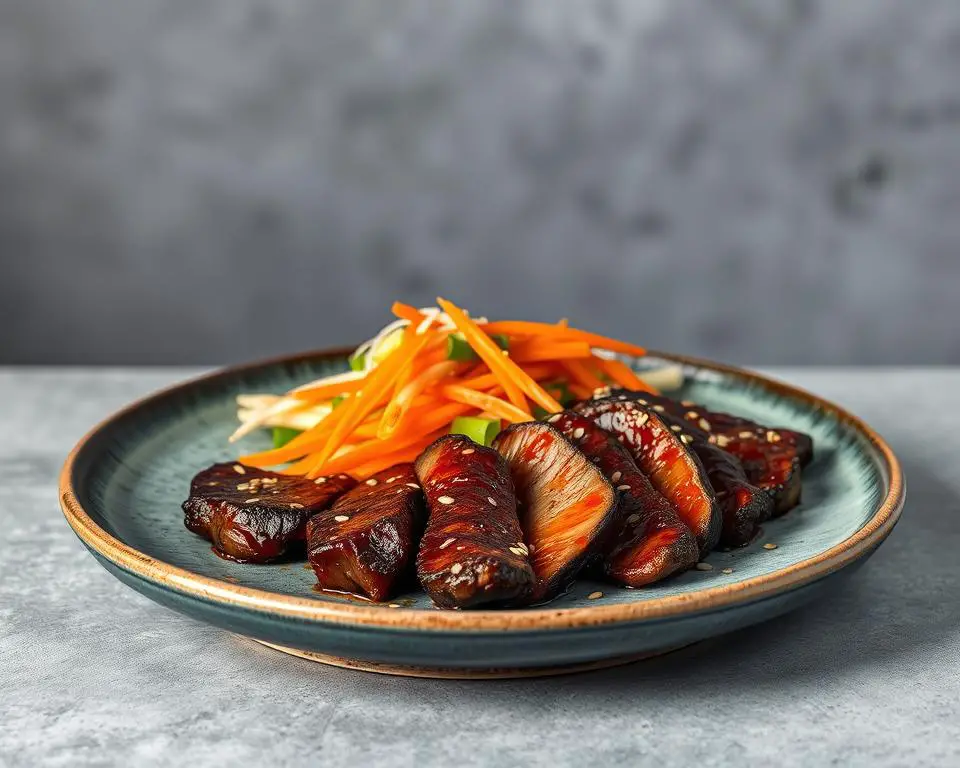
Korean Beef Tacos: A Fusion Twist
Korean Beef Tacos are a perfect example of how bold flavors can come together. I start with ground beef, marinated in a mix of soy sauce, garlic, ginger, and a pinch of red pepper flake for heat. Adding a splash of seasoned rice vinegar gives it a tangy kick.
For the filling, I use:
- 1 pound ground beef
- 1/4 cup soy sauce
- 1 tbsp grated ginger
- 1 tsp red pepper flake
Serve the beef in warm tortillas with kimchi slaw and a drizzle of sriracha mayo. It’s a quick, flavorful meal that’s perfect for busy weeknights.
Beef Bulgogi Mandu: Dumpling Delight
Beef Bulgogi Mandu combines the savory flavors of bulgogi with the comfort of dumplings. I use a mix of ground beef, garlic, and soy sauce for the filling. Adding finely chopped cabbage and green onions keeps the filling moist and flavorful.
To make the dumplings:
- 1 pound ground beef
- 1/4 cup soy sauce
- 1 cup finely chopped cabbage
- 2 cloves minced garlic
Steam or pan-fry the dumplings until golden and serve with a dipping sauce made from soy sauce, vinegar, and sesame oil. These dumplings are a crowd-pleaser every time.
For variety, I sometimes substitute chicken in these recipes. It’s a great way to mix things up while keeping the flavors bold and exciting. Whether you’re making tacos or dumplings, these fusion dishes are sure to impress.
Hearty Korean Soups and Rice Bowl Delights
Warm, hearty soups and rice bowls have always been my go-to comfort food, especially when they’re packed with bold flavors. These dishes are not only nourishing but also incredibly versatile, making them perfect for any occasion. In this section, I’ll share my favorite recipes for Yukgaejang, Tteokguk, and Beef and Kimchi Fried Rice—each offering a unique blend of tradition and innovation.
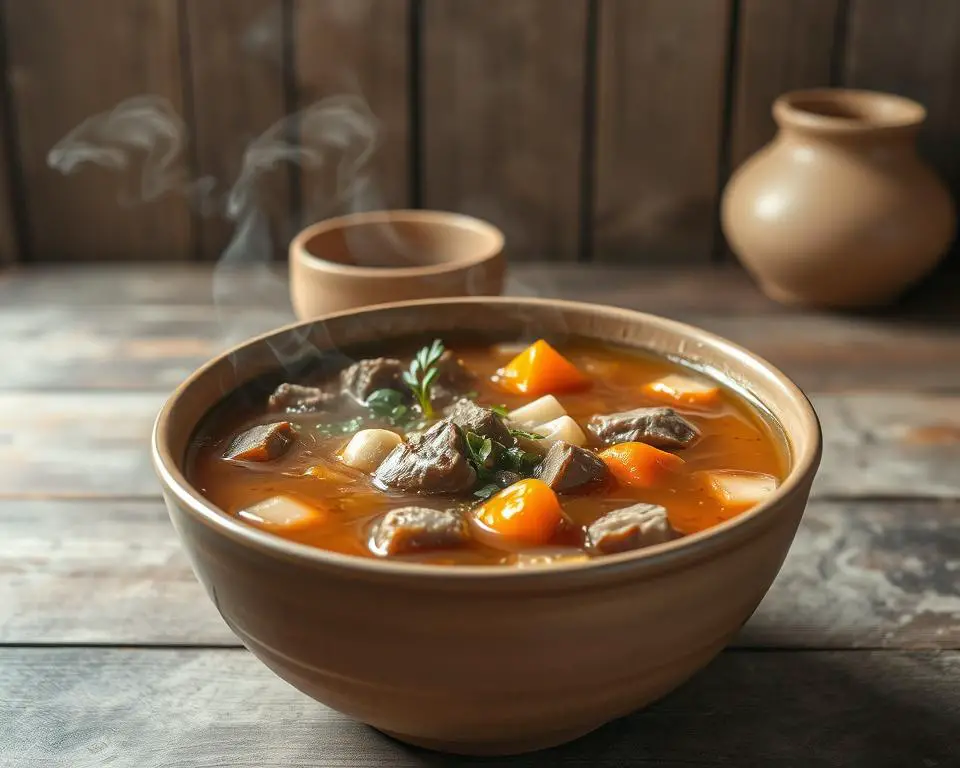
Yukgaejang: Spicy and Nutritious
Yukgaejang is a spicy soup that’s as nutritious as it is flavorful. Made with shredded beef, vegetables, and a fiery broth, it’s perfect for cold days. I like to simmer the beef for about 30 minutes to ensure it’s tender and juicy. Adding a touch of sugar balances the heat, while soy sauce enhances the umami flavor.
Here’s my go-to recipe:
- 1 pound shredded beef
- 4 cups beef broth
- 2 tbsp soy sauce
- 1 tsp sugar
- 1 cup mixed vegetables (fernbrake, bean sprouts)
Simmer for 30 minutes and serve hot. It’s a meal that warms you from the inside out.
Tteokguk: A Comforting Rice Cake Soup
Tteokguk is a traditional soup made with sliced rice cakes, often enjoyed during the New Year. The broth is light yet flavorful, and the chewy rice cakes add a delightful texture. I use ground beef for a richer taste, simmering it for about 20 minutes to infuse the broth with its savory essence.
Try this simple recipe:
- 1 cup sliced rice cakes
- 1/2 pound ground beef
- 4 cups beef broth
- 1 tbsp soy sauce
Cook until the rice cakes are soft, and garnish with green onions for a fresh finish.
Beef and Kimchi Fried Rice: Savory Surprise
Beef and Kimchi Fried Rice is a quick and satisfying dish that’s perfect for busy weeknights. The tangy kimchi pairs beautifully with the savory beef, creating a flavor explosion in every bite. I often use leftover rice and cook everything in one pan for under 15 minutes.
Here’s how I make it:
- 1 cup cooked rice
- 1/2 pound ground beef
- 1/2 cup chopped kimchi
- 1 tbsp soy sauce
Stir-fry until everything is well combined and serve in a bowl for a hearty meal.
| Dish | Key Ingredients | Cooking Time |
|---|---|---|
| Yukgaejang | Shredded beef, soy sauce, sugar | 30 minutes |
| Tteokguk | Rice cakes, ground beef, soy sauce | 20 minutes |
| Beef and Kimchi Fried Rice | Ground beef, kimchi, rice | 15 minutes |
Weeknight Wonders: Quick and Easy Korean Beef Meals
When life gets busy, I turn to quick and flavorful meals that don’t compromise on taste. These recipes are designed for weeknights when time is tight but you still crave something delicious. With minimal prep and common ingredients, they’re perfect for anyone looking to enjoy bold flavors without spending hours in the kitchen.
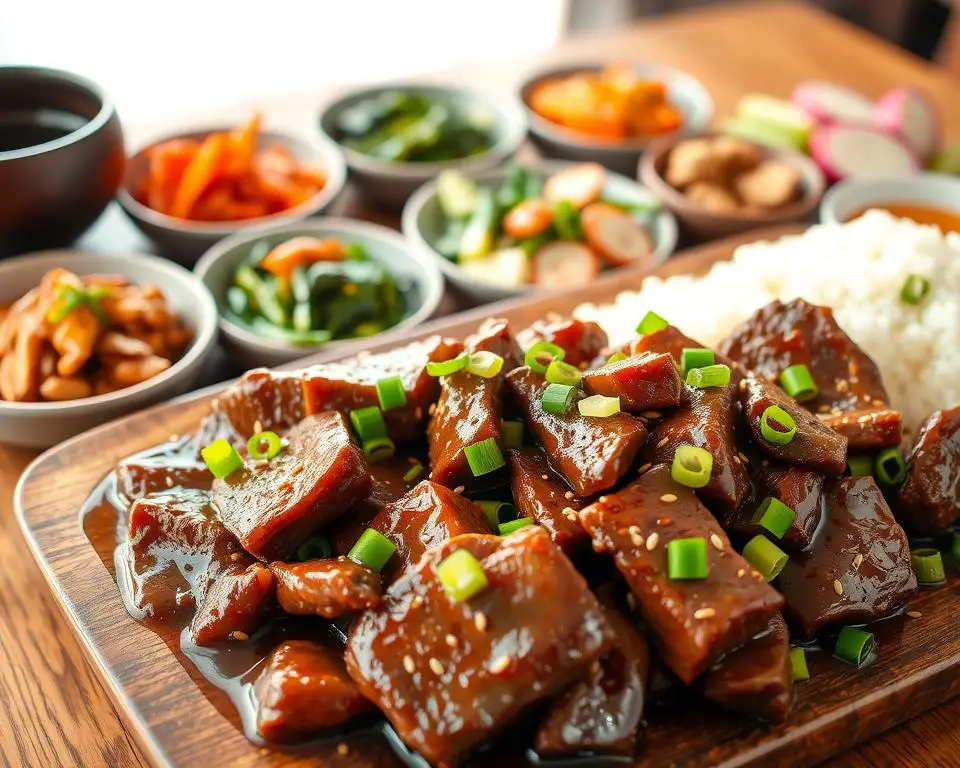
Beef Japchae: Stir-Fried Noodle Perfection
Beef Japchae is a dish I always rely on for a quick yet satisfying meal. It combines stir-fried glass noodles with lean beef and a mix of colorful vegetables. The key is to cook everything in a hot skillet to lock in the flavors.
Here’s how I make it:
- Cook 200g glass noodles according to package instructions.
- Stir-fry 200g thinly sliced beef in a skillet over medium heat until browned.
- Add 1 cup mixed vegetables (carrots, spinach, bell peppers) and sauté until tender.
- Toss the noodles with 2 tbsp soy sauce and 1 tbsp sesame oil, then combine with the beef and vegetables.
This dish is ready in under 20 minutes and is perfect for a busy evening.
Korean Ground Beef Rice Bowls: Simple and Flavorful
Korean Ground Beef Rice Bowls are another go-to for me. They’re packed with flavor and require minimal effort. I use ground beef as the base, seasoned with soy sauce, garlic, and a touch of sugar. Serving it over rice or spiralized veggies makes it a complete meal.
Here’s my method:
- Cook 1 cup rice or prepare spiralized vegetables as the base.
- In a skillet, brown 300g ground beef over medium heat.
- Add 2 tbsp soy sauce, 1 minced garlic clove, and 1 tsp sugar, stirring until well combined.
- Top with green onions and sesame seeds for garnish.
This dish is ready in just 15 minutes, making it ideal for a quick dinner.
| Dish | Key Ingredients | Prep Time |
|---|---|---|
| Beef Japchae | Glass noodles, beef, vegetables | 20 minutes |
| Korean Ground Beef Rice Bowls | Ground beef, rice, soy sauce | 15 minutes |
These recipes are proof that you don’t need to sacrifice flavor for speed. With a few simple steps, you can enjoy a taste of tradition even on the busiest nights.
Top 10 Korean Beef Recipes
Discovering the art of Korean beef cooking has been a journey of bold flavors and culinary creativity. Each dish offers a unique blend of tradition and innovation, making it easy to fall in love with these recipes. Below, I’ll walk you through the top 10 dishes, highlighting key ingredients and techniques to help you master them at home.
Recipe Rundown and Ingredient Highlights
Every recipe starts with the right ingredients. Here’s a quick rundown of the standout components that make these dishes shine:
- Bulgogi: Thinly sliced beef marinated in soy sauce, sesame oil, and a touch of brown sugar for sweetness.
- Galbi: Flanken-style ribs seasoned with garlic, ginger, and red pepper flakes for a spicy kick.
- Beef Japchae: Glass noodles paired with tender beef and colorful vegetables.
- Yukgaejang: Shredded beef simmered in a spicy broth with soy sauce and mixed vegetables.
- Beef and Kimchi Fried Rice: Tangy kimchi and savory ground beef combined with rice for a quick meal.
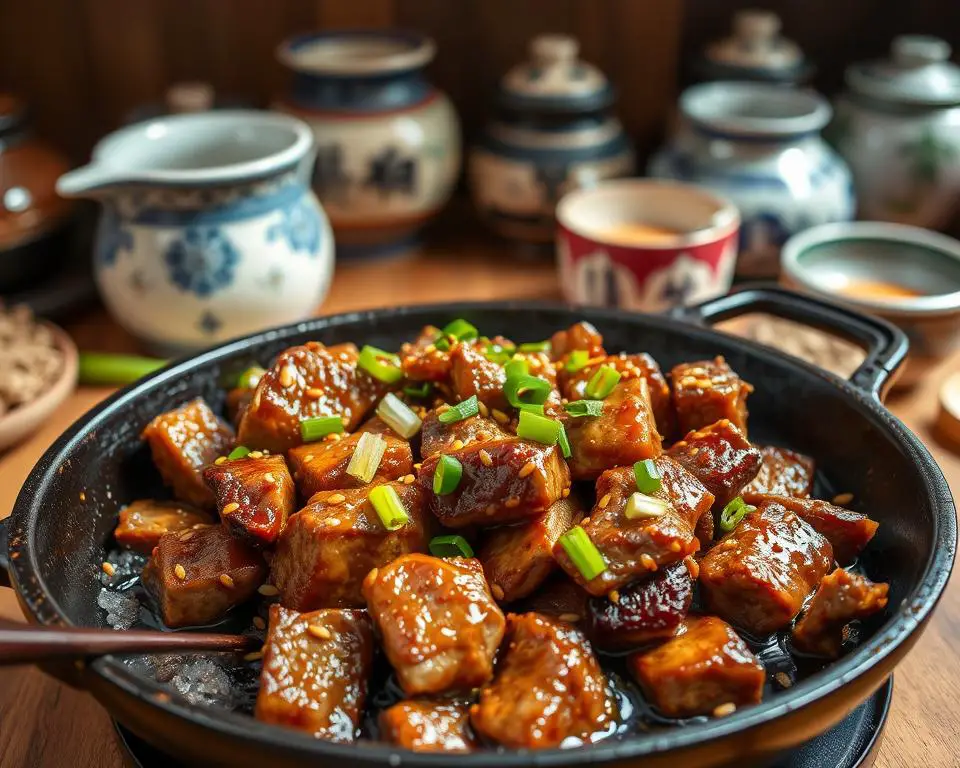
Cooking Techniques and Marinade Secrets
The magic of these dishes lies in the marinades and cooking methods. Here are some tips to ensure success:
- For Bulgogi, marinate the beef for at least 30 minutes to allow the flavors to penetrate. Use a hot skillet for quick cooking.
- When making Galbi, marinate the ribs overnight for maximum tenderness. Grill over medium heat to avoid burning.
- For Beef Japchae, stir-fry the beef and vegetables separately before combining with the noodles. This ensures even cooking.
- When preparing Yukgaejang, simmer the beef for 30 minutes to achieve a tender texture. Add a tablespoon of soy sauce for depth of flavor.
- For Beef and Kimchi Fried Rice, use leftover rice and cook everything in one skillet for under 15 minutes.
These recipes are proof that with the right ingredients and techniques, you can create restaurant-quality dishes at home. Whether you’re grilling, stir-frying, or simmering, each method brings out the best in these flavors.
Global Inspirations in Korean Beef Cooking
Exploring global flavors has always inspired me to experiment with traditional recipes. By blending international influences with classic techniques, I’ve discovered new ways to elevate familiar dishes. This fusion of tastes creates a unique culinary experience that’s both exciting and comforting.
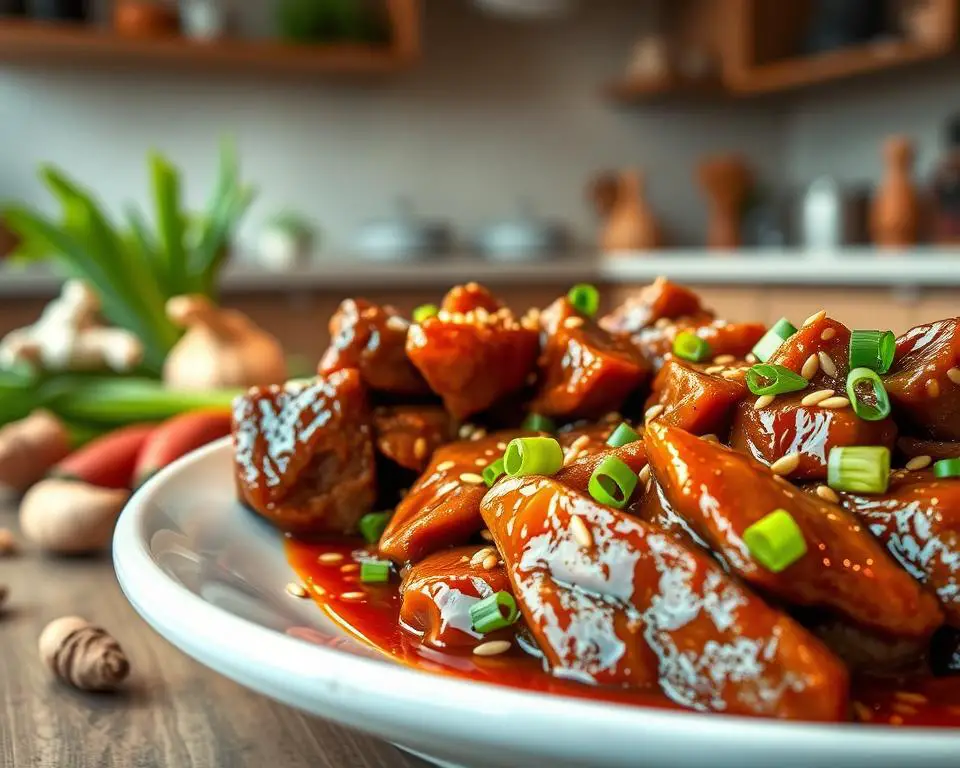
Embracing Fusion Flavors
One of my favorite experiments is adding a touch of sesame oil and soy to dishes like rice bowls. These ingredients bring depth and richness, while a sprinkle of red pepper flake adds a subtle heat. I’ve also enjoyed incorporating chicken as an alternative protein, which works beautifully with traditional marinades.
For example, a simple stir-fry with garlic, onion, and a splash of soy can transform a classic dish into something entirely new. The key is to balance the flavors, ensuring each ingredient shines without overpowering the others.
Mixing Traditional with Modern Methods
Modern cooking techniques have allowed me to reimagine traditional recipes. For instance, using a bowl to layer flavors creates a visually appealing and delicious meal. I’ve also found that adjusting ingredient ratios, like reducing the amount of oil, can make dishes lighter without sacrificing taste.
Another method I love is incorporating global spices into classic marinades. A pinch of pepper flake or a dash of sesame can add a fresh twist to familiar flavors. These small changes keep the essence of the dish intact while introducing new dimensions.
By embracing both traditional and modern approaches, I’ve been able to create dishes that honor their roots while appealing to a global palate. It’s a reminder that cooking is as much about innovation as it is about tradition.
Conclusion
Cooking has always been a way for me to connect with culture and creativity. Throughout this article, I’ve shared a mix of traditional and fusion dishes that highlight the versatility of these flavors. From savory marinades to quick weeknight meals, each recipe offers something special.
Whether you’re using a teaspoon of sesame oil or a cup of soy sauce, small adjustments can make a big difference. Garnishing with green onions or sesame seeds adds both flavor and visual appeal. I also encourage you to consider nutritional aspects, like managing fat and sodium, for balanced meals.
Experimenting with these dishes is a chance to explore new tastes and techniques. Whether you stick to tradition or try a fusion twist, every meal is an opportunity to create something memorable. I’d love to hear about your experiences and see how these recipes become part of your kitchen routine.


